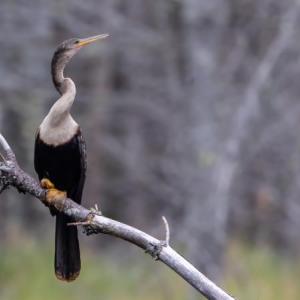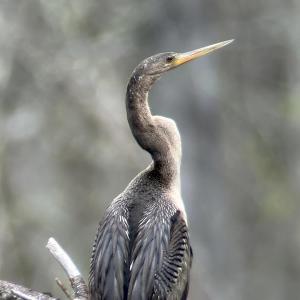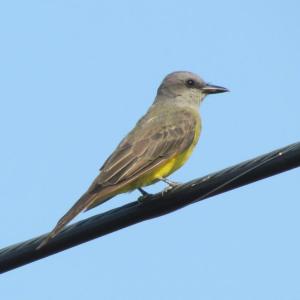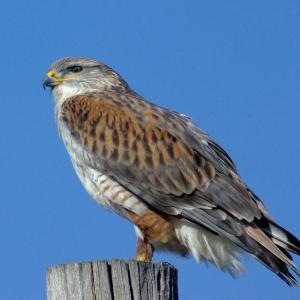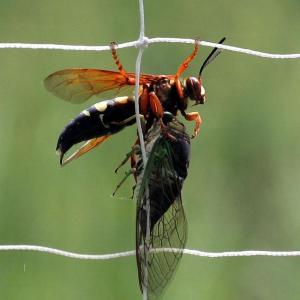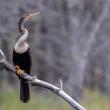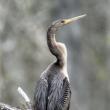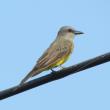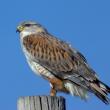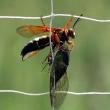The Weirdness Continues
 Imagine seeing this mysterious-looking bird in a beaver pond in Lincoln County, Maine. That’s where Maine’s first anhinga was recently discovered. Courtesy of Louis Bevier
Imagine seeing this mysterious-looking bird in a beaver pond in Lincoln County, Maine. That’s where Maine’s first anhinga was recently discovered. Courtesy of Louis Bevier
 With its long neck, you can see why anhingas are sometimes called “snake bird”. Courtesy of Louis Bevier
With its long neck, you can see why anhingas are sometimes called “snake bird”. Courtesy of Louis Bevier
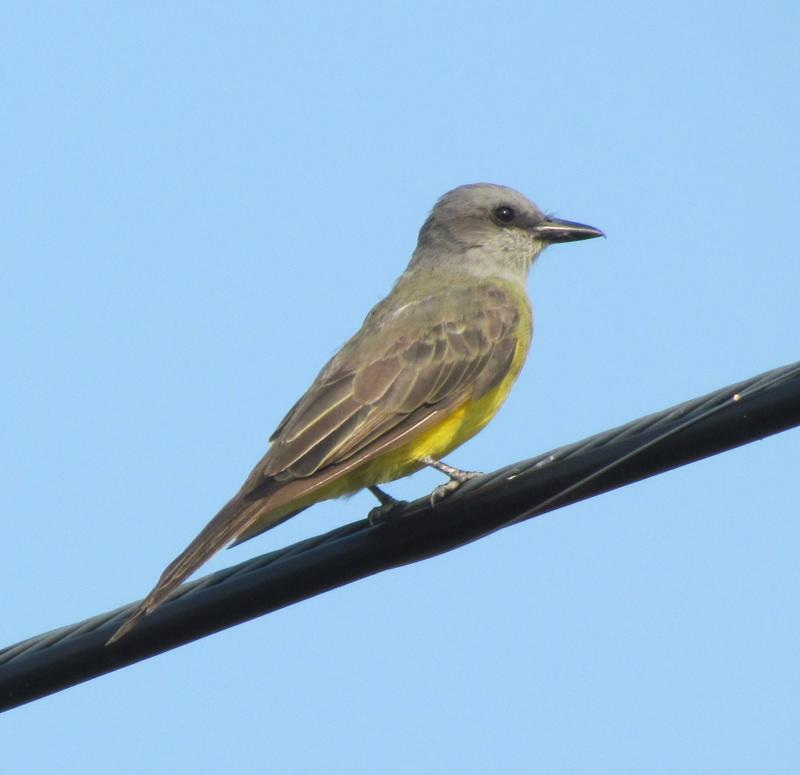 After reading reports (and writing about!) the tropical kingbird currently visiting Dayton, Maine, the authors decided to make the trip to see the bird themselves. Courtesy of Jeff Wells
After reading reports (and writing about!) the tropical kingbird currently visiting Dayton, Maine, the authors decided to make the trip to see the bird themselves. Courtesy of Jeff Wells
 A ferruginous hawk, like this one, is a species of the western US. It had never been recorded anywhere in New England until this past July, when one was found in Maine. Courtesy of Alan Schmierer
A ferruginous hawk, like this one, is a species of the western US. It had never been recorded anywhere in New England until this past July, when one was found in Maine. Courtesy of Alan Schmierer
 This large wasp parasitizes cicadas. The authors found one on the Kennebunk Plains while looking for birds. Photo by Bill Buchanan, U.S. Fish and Wildlife Service. Courtesy Wikimedia Commons
This large wasp parasitizes cicadas. The authors found one on the Kennebunk Plains while looking for birds. Photo by Bill Buchanan, U.S. Fish and Wildlife Service. Courtesy Wikimedia Commons
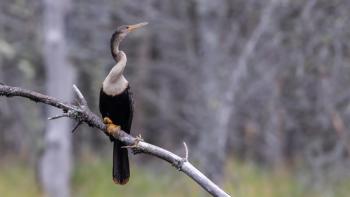 Imagine seeing this mysterious-looking bird in a beaver pond in Lincoln County, Maine. That’s where Maine’s first anhinga was recently discovered. Courtesy of Louis Bevier
Imagine seeing this mysterious-looking bird in a beaver pond in Lincoln County, Maine. That’s where Maine’s first anhinga was recently discovered. Courtesy of Louis Bevier
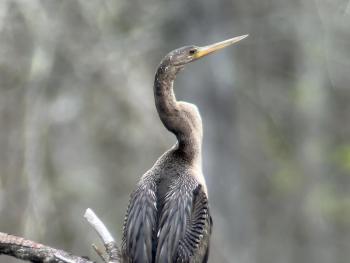 With its long neck, you can see why anhingas are sometimes called “snake bird”. Courtesy of Louis Bevier
With its long neck, you can see why anhingas are sometimes called “snake bird”. Courtesy of Louis Bevier
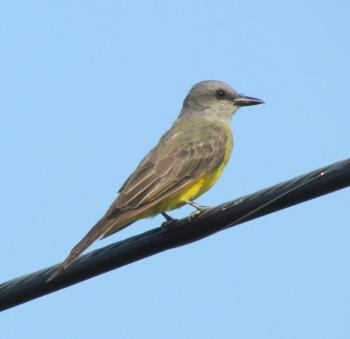 After reading reports (and writing about!) the tropical kingbird currently visiting Dayton, Maine, the authors decided to make the trip to see the bird themselves. Courtesy of Jeff Wells
After reading reports (and writing about!) the tropical kingbird currently visiting Dayton, Maine, the authors decided to make the trip to see the bird themselves. Courtesy of Jeff Wells
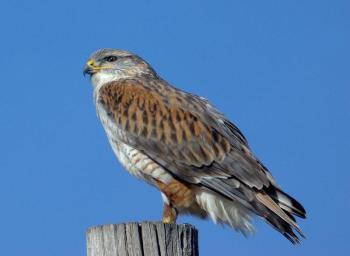 A ferruginous hawk, like this one, is a species of the western US. It had never been recorded anywhere in New England until this past July, when one was found in Maine. Courtesy of Alan Schmierer
A ferruginous hawk, like this one, is a species of the western US. It had never been recorded anywhere in New England until this past July, when one was found in Maine. Courtesy of Alan Schmierer
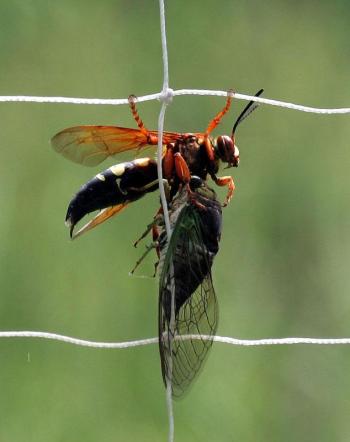 This large wasp parasitizes cicadas. The authors found one on the Kennebunk Plains while looking for birds. Photo by Bill Buchanan, U.S. Fish and Wildlife Service. Courtesy Wikimedia Commons
This large wasp parasitizes cicadas. The authors found one on the Kennebunk Plains while looking for birds. Photo by Bill Buchanan, U.S. Fish and Wildlife Service. Courtesy Wikimedia Commons
Over the weekend we decided to join in the birding fun that we wrote about in last week’s column: tracking down the thousands-of-miles-off-track tropical kingbird near the Skelton Dam along the Saco River in Dayton, Maine.
We expected a boat launch parking lot near the site where the bird had been seen, but we weren’t expecting the place to be swarming with vehicles parked with boat trailers seemingly everywhere. It was clear that a great many people were out on the river enjoying the hot, bright blue-sky summer day. Luck was with us, though, and sure enough there was one single spot left in the parking lot.
Not only did we find a place to park, but as we turned into the space, we glanced up on the nearby telephone wire and there was the tropical kingbird!
To be honest, it seemed a little too easy! Even as we stepped out of the car to get our binoculars, telescope, and camera from the back, the bird never moved from almost above our heads. We scanned it through binoculars and telescope for some time, and took some photos and video with the camera. Because the bird had been there so long and so reliably, most birders had apparently seen it some time ago, so we were the only ones there for the 30 minutes or so that we stayed. A man came off the water and asked us if we were flying a drone (maybe someone had been earlier?)! When we told him what we were doing, he was interested to learn about this third-ever tropical kingbird in Maine.
Soon after we wrote about this bird for last week’s column, we received word that an even more astonishing bird from down south had been found in Maine. It was Maine’s first ever anhinga! Otherwise known as the snakebird or the water turkey, the anhinga is a striking bird. Some would describe it has a prehistoric-looking bird. It sort of has the appearance of a cormorant whose neck and tail were stretched. We have seen anhingas lots of times in Florida where they are resident. But they only nest regularly up to coastal North Carolina and across to Texas. Their normal range extends south from there through Mexico and Central America and in South America south to Argentina.
A few days after the anhinga was reported, a western kingbird was found and photographed at the former Brunswick Naval Air Base. Interestingly, the western kingbird has yellow undersides like the tropical kingbird but is a smaller bill, has different vocalizations, and has a few other differences as well. The closest the species nests is in Minnesota. Small number do show up in fall migration here in Maine but not normally in summer. Oddly enough, another was photographed way out on Mount Desert Rock in June.
All of these weird birds were preceded by another Maine first that we hadn’t even brought up yet in these pages: a ferruginous hawk, found in mid-July at the Lewiston-Auburn airport. This was not only a first for Maine but apparently a first for all of New England!
After spending time with the tropical kingbird last weekend, we continued on to one of our favorite places, the Kennebunk Plains. We spent many summer days here back in the 1980s and 1990s so have very fond memories of seeing and hearing some amazing birds and learning lots about cool plants and insects as well. Late on this beautiful summer day, it was glorious to be among the golden grasses, green shrubs, and the occasional early flowering northern blazing star in its purple glory. With the breeding season largely over, there weren’t a lot of birds evident—some field sparrows, bobolinks, bluebirds.
Turns out, it was not a bird that really piqued our curiosity. It was an insect that we had never seen before. It was large and buzzed loudly. We couldn’t be sure if it was a type of moth or hornet or something entirely different. We did what you can in those situations and procured some photos and video.
Later, we were able to upload it into iNaturalist and discovered it was something called an eastern cicada-killer wasp. Just like its name suggests, it captures cicadas, paralyzes them, and puts them into a burrow dug in the sand. It lays an egg in the burrow and once the egg hatches, the larva eats the cicada. Despite their large size and appearance, eastern cicada-killer wasps are harmless to humans—they don’t have a protective stinger. We had never seen one of these cool creatures before and in iNaturalist, we didn’t find any Maine records prior to 2019. If there is an entomologist out there, maybe you can tell us if they are indeed a new arrival to Maine or if they have always been here.
All of this bird and bug weirdness leaves us wondering, what’s next?
Jeffrey V. Wells, Ph.D., is a Fellow of the Cornell Lab of Ornithology and Vice President of Boreal Conservation for National Audubon. Dr. Wells is one of the nation's leading bird experts and conservation biologists. He is a coauthor of the seminal “Birds of Maine” book and author of the “Birder’s Conservation Handbook.” His grandfather, the late John Chase, was a columnist for the Boothbay Register for many years. Allison Childs Wells, formerly of the Cornell Lab of Ornithology, is a senior director at the Natural Resources Council of Maine, a nonprofit membership organization working statewide to protect the nature of Maine. Both are widely published natural history writers and are the authors of the popular books, “Maine’s Favorite Birds” (Tilbury House) and “Birds of Aruba, Bonaire, and Curaçao: A Site and Field Guide,” (Cornell University Press).

